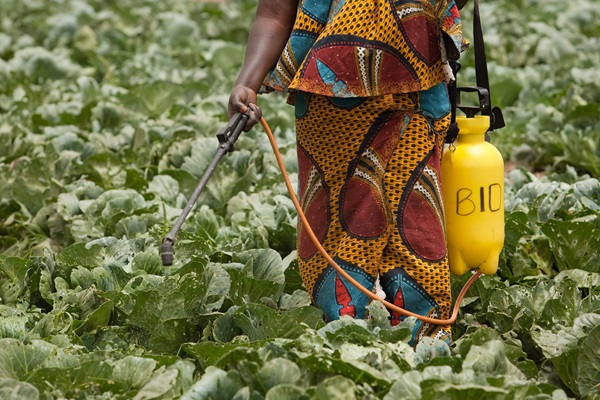The world’s agrifood systems are currently facing several serious challenges. These include climate change, environmental degradation, biodiversity loss, conflict, and high levels of social inequity. The challenges largely result from economic systems that have failed to fully recognize and appreciate the value of nature and climate for the long-term wellbeing of the planet and which focused on growth with disregard for the environment. This neglect has been detrimental to the environment in its broadest sense. To redress the balance between human activities and nature, a new economic model is required.
This has been termed “the bioeconomy model”, which is intended to promote sustainability through innovative design and implementation of integrated policies, strategies, technologies and practices, underpinned by robust monitoring frameworks. Following the International Advisory Council on Global Bioeconomy, FAO defines bioeconomy as “the production, utilization and conservation of biological resources, including related knowledge, science, technology, and innovation, to provide information, products, processes and services across all economic sectors aiming toward a sustainable economy”.
Sustainable and circular bioeconomy
Sustainable and circular bioeconomy is based on resource-efficient models that encourage reduction, recycling and reuse of natural resources, particularly those connected with food production, and development of innovative bio-based materials and energy that will replace traditional, resource-intense products. For instance, novel bio-based products (plastics, biofertilizers, alternative proteins and others) are used to replace unsustainable inputs and outputs in agriculture, processing and transport.
In January 2015, following the Global Forum for Food and Agriculture, held in Berlin, ministers of agriculture from more than 60 countries recommended that FAO coordinate international work on sustainable bioeconomy. To this end, the German Ministry for Food and Agriculture provided support to FAO to develop the Towards Sustainable Bioeconomy Guidelines project. FAO is the first UN agency to include bioeconomy as a priority area, specifically in its Strategic Framework 2022-31, under the heading “Bioeconomy for Sustainable Food and Agriculture”. Through this new programme, the Organization is moving towards systemic integration of sustainable bioeconomy in its work to scale up the achievements of several SDGs, particularly SDG 12, which addresses issues of responsible consumption and production.
FAO participates in many working groups and international fora on bioeconomy, including the International Sustainable Bioeconomy Working Group (ISBWG). This is an informal platform that facilitates knowledge exchange and provides guidance to national and regional stakeholders on the development of sustainable and circular bioeconomy strategies, programmes, and action plans. It also supports monitoring of the bioeconomy for sustainability, based on FAO’s Aspirational Principles and Criteria for a Sustainable Bioeconomy, agreed on by the ISBWG in November 2016.
What is leapfrogging for sustainability?
The concept of leapfrogging is important to the development of a bioeconomy that promotes sustainable production and reduces inequalities. This is because time is short. Progress towards the stated goals will be faster and more efficient if countries can bypass incremental practices and technological improvements and move directly towards more advanced, sustainable technologies and processes.
Leapfrogging enables this but will require that lessons are learned from past practices and that there is a willingness to change emphasis and direction in development objectives. Regarding agrifood systems, leapfrogging extends beyond food security and climate objectives to include, among other things, resource efficient economy, ecosystem restoration, increased employment, gender mainstreaming, and opportunities for youth.

Five central elements to make this happen
FAO's approach to supporting movement towards a sustainable bioeconomy includes five operational work areas: partnerships, policy dialogue, capacity development, normative and standard-setting instruments, supporting access to data and information and advocacy and communication. At a national level, The National Commission on Research, Science and Technology (NCRST) is collaborating with FAO to enhance Namibia’s sustainable and circular bioeconomy strategy. Since 2018, FAO has also provided support to Uruguay in its development of a circular bioeconomy strategy by supporting an intersectoral coordination mechanism that includes stakeholders from a broad range of national organizations.
Transitioning towards the bioeconomy is not without its risks, but FAO is well placed as a neutral convener and knowledge broker to provide a platform for discussion of benefits and trade-off issues related to bioeconomy practices, which are science- and evidence-based. For example, among the major issues that need to be considered are food safety and environmental impacts of novel biological products and processes. Other potential concerns relate to carbon footprints, affordability, scalability and effectiveness of alternative protein sources. Perhaps one of the areas that is the most challenging is that of regulation of innovative products that come from food loss and waste streams: who will regulate new products and what will the regulatory mechanisms comprise?
Lev Neretin leads the Bioeconomy for Sustainable Food and Agriculture Programme Priority Area and says, “All new and exciting technologies have an increasingly important role to play to address global food insecurity and malnutrition. However, development and deployment of these technologies and practices should follow a ‘sustainability path’, encompassing the entire spectrum of benefits and trade-offs, from environmental and carbon footprint to nutritional value and consumer acceptance. As a global voice to end hunger, promote food security and sustainable agriculture, FAO delivers unbiased knowledge, data and information to ensure that novel biological solutions remain sustainable in the long term.”
A move away from the linear economic model to a more sustainable and circular one using bioeconomy represents an important step towards addressing these challenges. FAO is committed to supporting its Members in deploying sustainable bioeconomy innovations as a part of agrifood system transformation.
FAO’s Chief Scientist’s says, “As we aim to build a greener future, biological innovations in the bioeconomy will be vital to transform the way we produce food, feed, and fibre and the way we use natural resources. Moving towards a more equitable and resilient economic model will also require social innovations for greater value addition by small-scale producers and a wider implementation of new practices. FAO's programmes on bioeconomy work with external partners to increase food security and nutrition, reduce waste, protect our precious ecosystems, mitigate climate change, enhance human and planetary health, and promote innovative production and consumption practices.”

